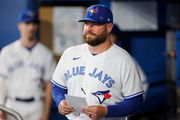
Imago
Credit: IMAGO

Imago
Credit: IMAGO
Cal Raleigh looked drained as he slumped into his locker, helmet still dangling from his hand. The Mariners’ ironman catcher has been logging heavy innings behind the plate, but lately the grind has turned brutal, more than the usual wear and tear of a 162-game season. Late-night finishes followed by early flights have piled up, leaving Seattle’s clubhouse searching for energy as much as for hits. What once felt like the normal September grind has turned into a test of endurance against a schedule that refuses to let them breathe.
Watch What’s Trending Now!
That tension boiled over when Ryan Divish of the Seattle Times laid out just how lopsided the demands have become. Seattle hasn’t just faced a long road stretch; they’ve endured one of the most punishing travel slates in baseball, bouncing from Baltimore to New York to Philadelphia, then back briefly to Seattle, only to be shipped out again to Cleveland, Tampa, and Atlanta. It’s a relentless back-and-forth across three time zones, stacked on top of the fact that five Mariners regulars have already logged over 135 games, the heaviest workload in the majors.
“Like the other night, we played in Tampa, 7:35 start time, and it’s a getaway day,” Divish explained on Foul Territory TV. “You’re flying to Atlanta, it’s a short flight, but the game gets over at 11:30. That’s late, and the big thing is these guys all want to get 12 hours of sleep. The sleep factor is a problem.” His words crystallize what fans have started to notice: fatigue isn’t just a whisper in the dugout; it’s written on every sluggish swing and dodgy base path jog.
ADVERTISEMENT
Mariners players have spoken about the lack of sleep they're getting due to the team's ridiculous travel schedule down the stretch, says @RyanDivish. pic.twitter.com/1euTig7Zff
— Foul Territory (@FoulTerritoryTV) September 5, 2025
The debate hasn’t stayed confined to the Mariners’ clubhouse. Fans on social media have mocked the complaints, comparing them to the Angels’ midseason gripes and pointing out that clubs like the Braves endured brutal getaway schedules without making headlines. Yet Seattle’s case feels different—not a flash flare, but a season-long structural burden baked into MLB’s calendar. When your team racks up thousands more flight miles than any peer, and your everyday starters are in the 135+-game club, it’s no longer whining; it’s a competitive sore point with real playoff implications.
What makes this controversy sting even more is how preventable it seems. Players and reporters alike have suggested simple solutions: bunch East Coast trips together, limit late-night getaway games, and rethink how the “balanced schedule” erodes both rest and divisional rivalries. MLB has been slow to adjust, leaving teams like Seattle carrying the cost of an experiment in fairness that doesn’t feel fair at all. And as Cal Raleigh and his teammates push toward October, their greatest battle may not be against an opposing lineup but against a league unwilling to admit its schedule is breaking down the very players it’s supposed to showcase.
ADVERTISEMENT
Cal Raleigh’s 51st blast puts him alone in history
Cal Raleigh’s swing on that sticky September night in Tampa wasn’t just another big-league blast; it was a shot that rewrote history. When the ball screamed into the right-field seats, he stood alone as the first primary catcher in MLB history to reach 51 home runs in a single season. One swing, one pitch left over the plate, and Raleigh’s name carved its place where no catcher’s ever been.
ADVERTISEMENT
The numbers make his season almost impossible to ignore. He’s sitting on 51 homers, more than anyone else in baseball, even powerhouses like Shohei Ohtani and Kyle Schwarber chasing five behind. And he’s not just hitting bombs for the highlight reels. His 109 RBIs rank top three across the majors, while his .926 OPS places him firmly among the game’s elite bats. Raleigh hasn’t simply powered through the grind of a catcher’s schedule; he’s turned it into a stage for dominance.
Then came the twist that makes his year even more staggering: he’s the first player in MLB history to hit 20+ home runs from both sides of the plate in a single season. That isn’t just brute force—it’s a testament to batting balance, adaptability, and sheer mental toughness to keep producing regardless of matchup. Factor in the physical toll of catching nearly every game—and the slog of that brutal schedule—and the feat towers even higher. For the Mariners, this isn’t just a star shouldering them toward October; it’s a catcher redefining what greatness looks like behind the plate.
Top Stories
Kyle Tucker Slowly Slips From Toronto’s Grip After Blue Jays Legend Confirms Bo Bichette Plan

Bo Bichette Hit With Blunt Reality Check As Red Sox Reportedly Exit Trade Talks Paving Way For Blue Jays Reunion

Cody Bellinger’s Yankees Exit Confirmed as Brian Cashman Warned of Drastic 2026 Fallout, Per Insider

Ross Atkins to Part Ways With 4 Players as Blue Jays Chase 25-Year-Old Nationals Star: MLB Trade Rumor

John Schneider Fires Sharp Shot at FOX Announcer Over Alleged Dodgers Bias Against Blue Jays in World Series

And as travel-bled bodies start dragging bases and batting eyes widen with fatigue, Raleigh’s historic surge feels all the more defiant—he’s not just surviving the grind; he’s thriving through it, and that makes this story all the richer.
ADVERTISEMENT
ADVERTISEMENT
ADVERTISEMENT
ADVERTISEMENT

